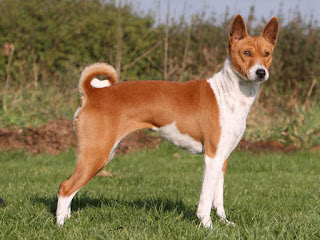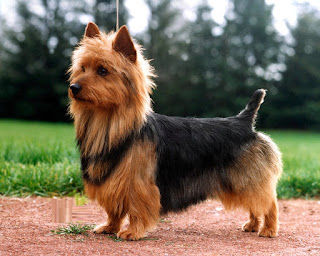Introduction:
The place of origin of Basenji is Zaire. The dog is a hound breed. Today it is used as lure coursing. The life span of Basenji is 10-14 years. The Basenji is also called as African Bush Dog, African Barkless Dog, Ango Angari, Congo Dog, Zande Dog.

Origin / History:
Nature / qualities:
The Basenjis are very intelligent, alert and energetic dogs. They have close and strong bond with their family members and are very affectionate. They are distrustful to strangers and will circle them like prey if they are not supervised. They are very protective to their home and owners. They need lots of exercise. If not given they become destructive. They are very playful dogs, so they love to run and climb over. If the owner likes to keep them in, then they need to have a high fence, as they like to climb. They are reserved with strangers and socialize well. They are not trusted with non-canine pets. They do not bark, but may yodel, howl, grow, or crow.
Physical Appearance:
The height of Male Basenji is 16-17 inches (41-43 cm) and the weight is 22-26 pounds (10-12 kg). The height of the Female Basenji is 15-16 inches (38-41 cm) and the weight is 20-25 pounds (9-11 kg). The Basenji is a muscular, medium size and lightly built dog. The head is flat and wrinkled. The eyes are almond shaped and dark hazel to dark brown in color. The nose is black in color. The ears are small and erect. The tail curled and set high. They have small and compact feet. The color of the Basenji is Chestnut red; pure black; tricolor (pure black and chestnut red); or brindle (black stripes on a background of chestnut red); all with white feet, chest and tail tip.
Health Concerns:
The Basenji is prone to Fanconi's syndrome (kidney problems), which must be treated the moment the symptoms are noticed. They are also prone to progressive retinal atrophy, intestinal, and eye problems.
Grooming:
Weekly brushing is recommended. They need lots of exercise to remain healthy.
Cost:
The cost of purchasing this breed is $ 1200 USD
Advantages:
Disadvantages:
The place of origin of Basenji is Zaire. The dog is a hound breed. Today it is used as lure coursing. The life span of Basenji is 10-14 years. The Basenji is also called as African Bush Dog, African Barkless Dog, Ango Angari, Congo Dog, Zande Dog.

Origin / History:
- The early Basenjis were brought from Central Africa to Egyptian pharaohs as gifts
- The credit for development of Basenji goes to Veronica Tudor Williams, who traveled through the remotest areas of Africa in search of specimens to better the strain
- The Basenjis were used as hunting dogs, pointing, retrieving, and bolting prey
- Basenji resembles those dogs portrayed in tomb paintings from ancient Egypt
- In 1934 the Basenjis were brought to Europe under the name of Congo dog
- In 1943 the Basenji was recognized by the American Kennel Club
Nature / qualities:
The Basenjis are very intelligent, alert and energetic dogs. They have close and strong bond with their family members and are very affectionate. They are distrustful to strangers and will circle them like prey if they are not supervised. They are very protective to their home and owners. They need lots of exercise. If not given they become destructive. They are very playful dogs, so they love to run and climb over. If the owner likes to keep them in, then they need to have a high fence, as they like to climb. They are reserved with strangers and socialize well. They are not trusted with non-canine pets. They do not bark, but may yodel, howl, grow, or crow.
Physical Appearance:
The height of Male Basenji is 16-17 inches (41-43 cm) and the weight is 22-26 pounds (10-12 kg). The height of the Female Basenji is 15-16 inches (38-41 cm) and the weight is 20-25 pounds (9-11 kg). The Basenji is a muscular, medium size and lightly built dog. The head is flat and wrinkled. The eyes are almond shaped and dark hazel to dark brown in color. The nose is black in color. The ears are small and erect. The tail curled and set high. They have small and compact feet. The color of the Basenji is Chestnut red; pure black; tricolor (pure black and chestnut red); or brindle (black stripes on a background of chestnut red); all with white feet, chest and tail tip.
Health Concerns:
The Basenji is prone to Fanconi's syndrome (kidney problems), which must be treated the moment the symptoms are noticed. They are also prone to progressive retinal atrophy, intestinal, and eye problems.
Grooming:
Weekly brushing is recommended. They need lots of exercise to remain healthy.
Cost:
The cost of purchasing this breed is $ 1200 USD
Advantages:
- The Basenjis are patient and eager to please
- They are well with older children as compared to young ones
Disadvantages:
- They chase small animals as they do not like and catch and kill them if given chance
- They do not get along with other dogs

